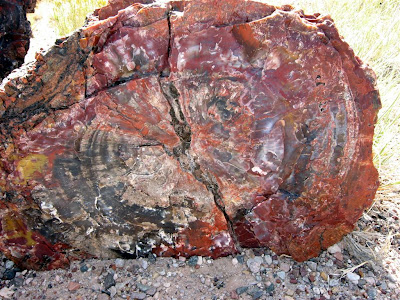Next stop on our list was the Petrified Forest National Park. We passed the entrance on I-40 as we drove toward Holbrook. Looking around, we asked each other if it was really worth the night's stay at Holbrook and the 30 mile drive back to the park. We decided we were too close to the park not to see it. After all, any national park has to be worth seeing, right? Absolutely. We are so glad we took the time to spend a day there.
The park is actually 2 parks in one, the Painted Desert and the Petrified Forest. Not visible from the interstate, we were amazed at the beauty of the desert.
 The Painted Desert actually runs all the way from here to the Grand Canyon. It has been said that there are "168 distinct colors and shades in the sands of the Painted Desert, and to any beholder this seems conservative, rather that an exaggeration".
The Painted Desert actually runs all the way from here to the Grand Canyon. It has been said that there are "168 distinct colors and shades in the sands of the Painted Desert, and to any beholder this seems conservative, rather that an exaggeration". The northern half of the 28 mile park road runs through the Painted Desert. An interesting stop is the Painted Desert Inn, a museum renovated by the Civilian Conservation Corps in the 30's on the site of a popular inn on historic Route 66.
The northern half of the 28 mile park road runs through the Painted Desert. An interesting stop is the Painted Desert Inn, a museum renovated by the Civilian Conservation Corps in the 30's on the site of a popular inn on historic Route 66.As you travel south on the road, you begin to spot chunks of petrified logs. I had a vague concept of how petrified wood was formed before visiting the park, but the movie shown at the Painted Desert Visitor Center was excellent in its explanation, as is the park brochure:
"This high, dry grassland was once a vast floodplain crossed by many streams. Tall, stately conifer trees grew along the banks. A variety of plants and animals lived there, known only as fossils today. The trees fell, and swollen streams washed them into adjacent floodplains. A mix of silt, mud and volcanic ash buried the logs. This sediment cut off oxygen and slowed the logs decay. Silica laden groundwater seeped through the logs and replaced the original wood tissues with silica deposits (cell by individual cell). Eventually the silica crystallized into quartz, and the logs were preserved as petrified wood."
Think of that. The original wood cells were replaced, retaining the grain and texture, by gemstone! The resulting display is amazing.
 The color patterns are gorgeous, including yellow, red, black, blue, brown, white and pink. Petrified wood is surprisingly heavy, weighing 200 pounds per cubic foot.
The color patterns are gorgeous, including yellow, red, black, blue, brown, white and pink. Petrified wood is surprisingly heavy, weighing 200 pounds per cubic foot.In the mid 1800's stories of this unusual place were carried back east, and before long, pioneers and sightseers were common in the area. Naturally, everyone who visited stooped to choose a piece to carry home, and much of it was pilfered to be sold locally as souvenirs. Finally in 1906, sections of the area were set aside to be federally protected, and in 1962, those areas plus more than 50,000 more acres became the Petrified Forest National Park. Today, federal law prohibits the removal of even a small chip, but only a fraction of the original petrified logs remain.
 During the last few days, we have seen many reminders of the Historic Route 66, which ran through the center of the park. The community of Holbrook holds many such remnants of the "Mother Road" which made travel through the west so popular.
During the last few days, we have seen many reminders of the Historic Route 66, which ran through the center of the park. The community of Holbrook holds many such remnants of the "Mother Road" which made travel through the west so popular.For more scenes from our trip through the National Park click here for our slideshow:


No comments:
Post a Comment